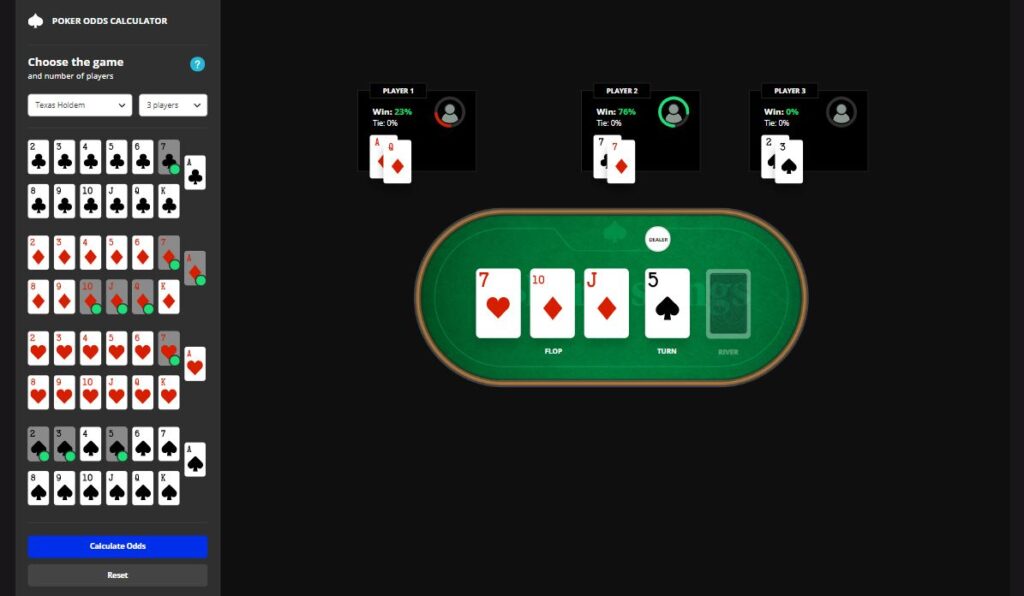Use calculations with your probability theory to calculate the odds in poker.
Benefits of Poker Calculating Poker Odds
For mathematical completeness, this article presents theory calculations needed to Calculate Odds for Poker. Viewers should be familiar with simple functions used in probability theory, e.g., the factorial method or the beta function. Theory will be used to calculate the the pooled size of the pot, the payoff for a call, and the odds of an opponent calling a bet your make.
Pot size and pot odds are the two most important aspects of Calculate Odds for Poker theory. slot online Depending on these, the size of bets players should make will vary and the odds of winning wagers made will also.

Pot odds are the ratio of the size of the bet versus the size of the pot. Let’s consider the scenario where half the players at the table put in a bet and the pot is $500. In this case, the ratio of the size of the bet to the size of the pot is 5:1. Also in this case, 5 people are requiring to be called and there are 5 calls made. Beta test your Calculate Odds for Poker theory against this case, and see the improvement.
Calculating Poker Odds
Once you understand the logic of pot odds and odds, the next step is to calculate the odds of making certain bets. This can be done with the help of a Finally, the odds of making a bluff is equal to the odds of making a bet on the flop when there is only one card on the flop.
ao Bets to Call: The odds of calling a bet are equal to the odds of winning the bet placed.
ao Bets to Come: The odds of coming out with a pair are equal to the odds of finishing with a better hand.
ao Tilt: Tilt is the betting pattern of going on tilt.
Goals of Poker Theory
After knowing the goals of poker theory, you need to understand the relationship between the two. You have to calculate your pot odds and call odds. Call odds are the size of the bets required. In the situation of multi-way pots, you need to calculate the call odds of the outs to compare with your pot odds. To learn these skills, you need to practice on your own first, then read this article.
Calculating Poker Odds
The odds of achieving a particular hand are the ration between the odds of getting the hand you want and the odds of not getting the hand you want. Take note that the odds of achieving a straight are 3 to 1, and the odds of not achieving a straight are 2 to 1.
There are certain times when it is in your best interest to call rather than raise. When you have a hand that is unlikely to be beaten even if raised, do not call. In most cases, you should raise.
Knowing when to call is the most difficult part of poker. You have to decide whether to call to increase the size of the pot or to protect your hand. Usually you should raise in late position in order to get additional bets on the flop. Do this in situations where you have the right to do it, for example if you tried to steal the pot in the previous round of betting but everyone still calls.
Note that when you have a marginal hand, you should prefer to call rather than raise when your opponent will likely call the raise. You do not want to place additional bets in the hopes of getting a very high-valued hand. For example, a flush would be next to impossible to be beaten when you have 5 spades in the mix.
Consequently, you should never slow-play. Slow-playing simply means to play passively on the table, calling each bet on the flop and turn in a way to let your opponents decide whether to go forward with aggression or not.
You should give your opponents the opportunity to bet first. Do not wait until you have a huge hand, for then you’ll be sure to attract plenty of bets.
If possible, try to give your opponents negative expectation, this way betting will be Emily’s forever.
Now that you have the basics, you can’t help but get carried away with poker. Always remember to stop before you start to lose a lot of money. When you’re on a winning spree, it’s easy to forget about the bankroll and what you’re doing http://onbase-wiki.cuc.claremont.edu/images/slot-gacor.